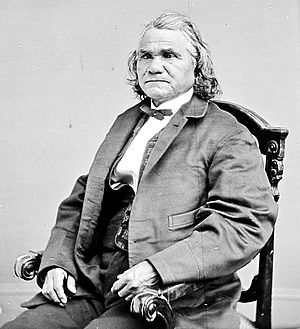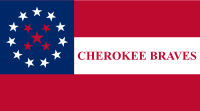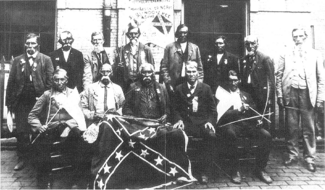Cherokee in the American Civil War facts for kids
The Cherokee people played an important part in the American Civil War. They were active in two main areas: the Trans-Mississippi region (which is now mostly Oklahoma) and the Western areas (like the Appalachian mountains).
In the east, some Cherokee, led by William Holland Thomas, helped the Confederate side. They made it hard for Union soldiers to use mountain passes in western North Carolina and eastern Tennessee. Out west, a Cherokee leader named Stand Watie led mostly Native American forces for the Confederacy in the Indian Territory.
The Cherokee joined the Confederacy for several reasons. They hoped to get money and, most importantly, to be fully recognized as an independent nation.
Contents
Why Did the Cherokee Join the War?
Before the Civil War, the Cherokee Nation lived in the Blue Ridge Mountains. This area included parts of North Carolina, Tennessee, South Carolina, and Georgia. The United States government forced most Cherokee people to move west of the Mississippi River. This difficult journey is known as the Trail of Tears. After this, the main Cherokee Nation was based in the west. However, some Cherokee stayed in the Blue Ridge Mountains.
Many Cherokee blamed the U.S. government and former President Andrew Jackson for the Trail of Tears. Before their forced removal, the Cherokee had adopted many "Southern ways." Like many Southern states, some Cherokee people owned enslaved people. They also made laws that limited the rights of Black people.
The Cherokee decided to side with the Confederacy partly because they already had strong cultural and trade ties with the Southern states that had left the Union. Also, a politician named William H. Seward campaigned in 1860 for Abraham Lincoln. Seward suggested that Lincoln might open the Indian Territory for white settlers. This worried the Cherokee, making them more likely to support the Confederacy.
Cherokee in the West: Trans-Mississippi Theater
The main chief of the Cherokee, John Ross, believed the Union should stay together. But another important Cherokee leader, Stand Watie, chose to join the Confederate cause. On June 1, 1861, Watie began gathering all-Indian military units for the Confederate army.
Generally, full-blooded Cherokee people supported Chief Ross. Many mixed-blooded Cherokee supported Stand Watie, who was three-quarters Cherokee. In 1862, Stand Watie was chosen as Chief of the new Southern Cherokee Nation.
Throughout the war, Cherokee soldiers fought many small battles and used guerrilla warfare tactics in the Indian Territory. Stand Watie was the very last Confederate general to stop fighting. He officially ended his fight on June 25, 1865, at Fort Towson. This was in the southeastern part of the Indian Territory. Watie and his group, the First Indian Brigade, were allowed to go home with their weapons instead of formally surrendering.
How Were Cherokee Soldiers Organized?
During the Civil War, the Cherokee Nation had about 21,000 members. About 3,000 of them served as soldiers for the Confederacy.
Here are some of the units they formed:
- First Cherokee Mounted Rifles
- 1st Regiment of Cherokee Mounted Volunteers
- 2nd Regiment of Cherokee Mounted Volunteers
- 3rd Cherokee Regiment of Volunteer Cavalry
- Cherokee Regiment (Special Services), CSA
- 1st Cherokee Battalion of Partisan Rangers
- 2nd Cherokee Artillery
- Cherokee Special Services Battalion
- Scales' Battalion of Cherokee Cavalry
- Meyer's Battalion of Cherokee Cavalry
- Cherokee Battalion of Infantry
- 1st Squadron of Cherokee Mounted Volunteers
What Were Some Key Battles?
Cherokee soldiers took part in many battles and smaller fights. Some of these included:
- Battle of Wilson's Creek (August 10, 1861)
- Battle of Bird Creek (December 9, 1861)
- Battle of Chustenahlah (December 26, 1861)
- Battle of Pea Ridge (March 6–8, 1862)
- Battle of Prairie Grove (December 7, 1862)
- Battle of Honey Springs (July 17, 1863)
- First Battle of Cabin Creek (July 1–2, 1863)
- Ambush of the steamboat J. R. Williams (June 15, 1864)
- Battle of Fort Smith (July 31, 1864)
- Second Battle of Cabin Creek (September 19, 1864)
Cherokee in the East: Western Theater

Thomas' Legion was a group of soldiers led by William H. Thomas. He was a European-American man who had been adopted by the Cherokee. This group was first stationed near Knoxville, Tennessee. Their main job was to protect the Alum Cave and bother Union troops in Tennessee.
In June 1862, while working near Chattanooga, Tennessee, Thomas himself captured a Union soldier. After this, each of his men promised to capture at least one "Yankee" before the war ended.
Thomas' Legion became well-known for their actions on September 15, 1862. A popular Cherokee leader named Astoogahtogeh was killed while leading a charge. This happened as they tried to stop a Union advance through Baptist Gap. The remaining Cherokee soldiers were very angry and wanted revenge. When newspapers reported this event, Union soldiers began to fear the Cherokee. However, Thomas worried about the Cherokee's reputation. He did not want his people to be seen as wild or uncivilized.
In February 1864, some of Thomas' men were captured. The Union convinced some of them that they were fighting for slavery. These men then switched sides and fought for the Union. Others pretended they would switch sides but returned to Thomas. They told him that Union officials offered $5,000 to capture him. After this, many of Thomas' men were sent to fight in Virginia. Some were even present at Appomattox Court House when General Robert E. Lee surrendered. The rest of Thomas' Legion continued fighting until May 10, 1865. They surrendered along with their commanding officer to the Union commander they had captured.
How Was Thomas' Legion Organized?
In May 1861, William H. Thomas began recruiting Cherokee people from the Quallatown area of North Carolina. The first two companies were mostly made up of Native American soldiers. They were called the Junaluska Zouaves. Thomas' Confederate soldiers were sometimes called Thomas' Legion or Thomas' Legion of Cherokee Indians and Highlanders. Later, they were officially named the 69th North Carolina Regiment.
Here is how the 69th North Carolina Regiment was organized:
- 69th North Carolina Regiment
- Field & Staff: Colonel William H. Thomas, Lieutenant Colonel James R. Love, Major William W. Stringfield, Luther C. May (Adjutant), James W. Terrell (A.Q.M.), John W. Lawing (Surgeon), and Hezekiah West (Chaplain)
- Companies: Company A (Captain James W. Terrell), Company B (Captain G. M. Hanks), Company C (Captain Elisha G. Johnson), Company D (Captain William B. Love), Company E (Captain Julius M. Welch), Company F (Captain J. M. McConnell), Company G (Captain Daniel G. Fisher), Company H (Captain Thomas J. Cooper, Captain James W. Cooper), Company I (Captain Willis Parker, Captain Joseph A. Kinsey), Company K (Captain Thomas A. Butler)
- Total: 1,125 men
What Happened After the War?
The eastern Cherokee faced a serious smallpox outbreak after the war. Thomas and many of his followers were deeply in debt. Because of this, the U.S. government recognized the eastern Cherokee tribe as separate from the western tribe. The government also helped the Cherokee with their debts, which meant the federal government protected them.
In the west, after the Union won the war, the Union-supporting Cherokee made new rules. These rules took land away from the Confederate Cherokee. However, the U.S. government promised the Confederate Cherokee that these land-taking laws would be canceled. This was partly due to Indian Commissioner D.N. Cooley. He saw a chance to create a split between the Cherokee groups, those who supported Ross and those who supported Watie. Cooley even tried to make Chief Ross look like a traitor, even though Ross had always supported the Union.
The Cherokee were forced to accept their former enslaved people as members of their tribe. They also had to allow white settlers onto their lands. Because of the split among the Cherokee and Cooley's actions, the Cherokee suffered greatly during the period known as Reconstruction.
Monuments
In the early 1900s, monuments were built to honor the Cherokee's part in the war.




